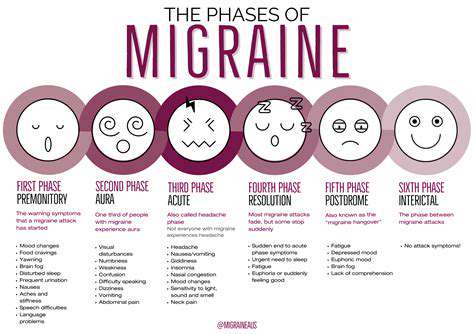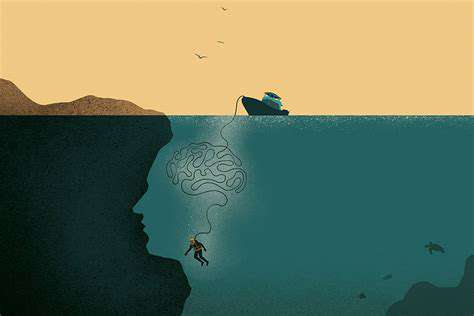
Understanding the Triggers
Migraines, those intense headaches that can derail entire days, frequently arise from multiple interconnected causes. While most people blame stress or skipping their morning coffee, environmental shifts like sudden storms or overpowering perfumes often play an equally important role in sparking these painful episodes. Pinpointing your unique triggers becomes essential for reducing both how often migraines strike and how badly they hurt. Many find that keeping detailed records over several months helps uncover hidden patterns preceding their headaches.
Surprisingly, everyday foods like sharp cheddar or deli meats might secretly trigger attacks. Combining smarter food choices with relaxation practices frequently leads to noticeable drops in migraine occurrences. What's crucial to understand is that migraine experiences vary wildly between individuals - discovering your personal triggers demands both time and careful observation.
The Neurological Perspective
Neurologists explain that migraines involve misfiring in the brain's trigeminal nerve network and related blood vessels. These malfunctions can release inflammatory chemicals that create that familiar pounding sensation and accompanying symptoms. Cutting-edge studies continue unraveling the complex biological processes behind these neurological reactions, promising better future treatments and prevention methods.
Grasping migraine's neurological foundations proves vital for crafting effective care plans. This deeper understanding enables healthcare providers to develop precisely targeted approaches, potentially decreasing both how often migraines happen and how severe they become over time.
The Emotional Connection
Migraines rarely come alone - they often bring unwelcome emotional guests like anxiety or sadness. The relentless pain can color entire days gloomy, affecting both mood and general outlook. Recognizing these emotional side effects forms a critical part of comprehensive migraine care.
Those experiencing frequent migraines commonly report mounting stress levels, which ironically can feed back into making migraines worse. On the brighter side, proven stress-reduction methods like focused breathing or meditation can help break this vicious cycle.
Lifestyle Considerations
Smart daily habits serve as powerful allies in the fight against migraines. Eating plenty of colorful produce, whole grains and lean proteins provides nutrients that may help ward off attacks.
Sleep quality matters tremendously. Skimping on rest often invites or intensifies migraines, underscoring sleep's critical role in prevention. While exercise benefits overall health, migraine sufferers should pace themselves - overly intense workouts might backfire.
Potential Benefits of the Condition
Despite their obvious drawbacks, some researchers speculate migraines might correlate with heightened mental abilities. Anecdotal reports describe bursts of creativity or sharpened focus following migraine episodes, though scientific confirmation remains pending.
Treatment and Management Options
The treatment toolbox ranges from basic painkillers to specialized prescriptions. Consulting a doctor ensures selecting options matching individual needs and sensitivities, creating care plans that address specific symptoms and triggers.
Successful migraine control typically blends medication with lifestyle tweaks and stress-busting techniques. The ultimate goal? Developing strategies that minimize migraines' disruption to daily living.
Beyond the Pain: Exploring the Underlying Messages

Unveiling the Root Causes
Getting to the heart of chronic pain requires looking beyond surface symptoms. Numerous elements contribute - from old injuries and inflammation to emotional strain and daily habits. Mapping these contributing factors marks the starting point for personalized, effective pain solutions. This detective work demands considering someone's complete health picture - past and present, body and mind.
The emotional weight of persistent pain often proves as burdensome as the physical discomfort itself. Anxiety and depression frequently join the mix, creating exhausting cycles where pain worsens mood and poor mood intensifies pain. Tackling both physical and emotional dimensions simultaneously becomes essential for meaningful improvement. Optimal care often involves teams including doctors, therapists and supportive loved ones.
Strategies for Effective Management
Truly managing pain means more than masking symptoms - it involves multidimensional approaches addressing root causes while improving life quality. Options span traditional physical therapies to complementary practices like acupuncture or meditation, with individual responses varying widely.
Daily choices powerfully influence pain levels. What we eat, how we sleep and how we handle stress all play significant roles. Cultivating healthy routines and supportive environments can dramatically ease discomfort while boosting overall wellness. Additionally, maintaining strong social ties helps shoulder pain's emotional burden.
Professional guidance proves invaluable when navigating pain management. Specialists can tailor recommendations and treatments to individual circumstances. This expert support helps patients access appropriate care while developing personalized coping strategies. Successful outcomes depend on open, ongoing dialogue between patients and providers.
Some find relief exploring alternative therapies alongside conventional treatment. However, always consult healthcare providers before trying new approaches or supplements.
Modular shelving solutions offer exceptional flexibility for small bathroom organization. These adaptable systems allow homeowners to reconfigure components as needs change. Their space-saving design proves particularly valuable in compact bathrooms, with sturdy materials like steel or hardwood ensuring lasting performance.
Migraine as a Teacher: Learning from the Experience

Understanding the Connection
While migraines manifest physically, their effects ripple through all aspects of life, especially for professionals like educators. Recognizing migraine's full spectrum - physical discomfort, emotional strain and cognitive effects - enables better coping strategies. This comprehensive understanding helps teachers develop effective methods for managing migraine's professional challenges.
The Impact on Daily Function
Migraine attacks can completely disrupt a teacher's workday. Maintaining classroom engagement requires sharp focus and steady energy - exactly what migraines steal away. When migraine strikes, delivering effective lessons becomes enormously challenging, potentially affecting both teacher and student experiences. This can lead to missed instructional opportunities and increased stress all around.
Emotional Toll and Coping Strategies
Migraines exact a heavy emotional price. The frustration and isolation caused by recurring pain can feel overwhelming. Developing robust coping mechanisms - from stress reduction techniques to proactive pain management - helps teachers maintain emotional balance despite migraine challenges.
Communication and Support Systems
Transparent discussions with school administrators and colleagues create vital support networks. Openly addressing migraine's impact on teaching performance fosters understanding and accommodation. Potential adjustments might include schedule flexibility or temporary duty modifications during difficult periods.
Strategies for Prevention and Management
Proactive migraine prevention proves essential for educators. This involves trigger identification, healthy habit cultivation and regular stress management practice. Implementing these measures can dramatically reduce migraine frequency and intensity, helping teachers maintain consistent classroom presence. Regular medical consultations ensure care plans stay current and effective.
Seeking Professional Help and Resources
Consulting healthcare professionals remains critical for proper diagnosis and treatment. Teachers battling migraines should partner with their doctors to explore all therapeutic options and symptom management techniques. Additionally, migraine support communities offer valuable shared experiences and practical advice for navigating professional life with this condition.